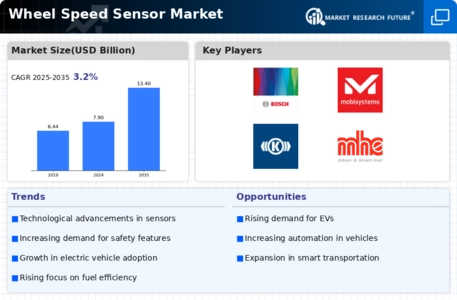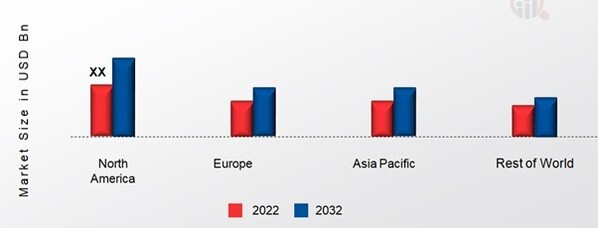-
EXECUTIVE SUMMARY
-
MARKET INTRODUCTION
-
2.1.
-
Definition
-
Scope of the Study
- Research Objective
- Limitations
-
2.2.2.
-
Assumptions
-
RESEARCH METHODOLOGY
-
Overview
-
Data Mining
-
Secondary Research
-
Primary Research
- Breakdown of Primary
-
3.4.1.
-
Primary Interviews and Information Gathering Process
-
Respondents
-
Forecasting Model
-
Market Size Estimation
- Top-Down Approach
-
3.6.1.
-
Bottom-Up Approach
-
Data Triangulation
-
Validation
-
MARKET DYNAMICS
-
Overview
-
Drivers
-
Restraints
-
Opportunities
-
MARKET FACTOR ANALYSIS
-
5.1.
-
Value Chain Analysis
-
Porter’s Five Forces Analysis
- Bargaining
- Bargaining Power of Buyers
- Threat of
- Threat of Substitutes
- Intensity of Rivalry
-
Power of Suppliers
-
New Entrants
-
COVID-19 Impact Analysis
- Market Impact Analysis
- Opportunity and Threat Analysis
-
5.3.2.
-
Regional Impact
-
GLOBAL WHEEL
-
SPEED SENSOR MARKET,BY TYPE
-
Overview
-
Hall Type
-
Magnetic
-
Electric Type
-
GLOBAL WHEEL SPEED SENSOR MARKET,BY APPLICATION
-
7.1.
-
Overview
-
Passenger Vehicle
-
Commercial Vehicle
-
GLOBAL
-
WHEEL SPEED SENSOR MARKET, BY REGION
-
Overview
-
North America
- US
- Canada
-
Europe
- Germany
- UK
- Italy
- Spain
- Rest of Europe
-
8.2.2.
-
France
-
Asia-Pacific
- China
- India
- Japan
- Australia
- Rest of Asia-Pacific
-
8.3.4.
-
South Korea
-
Rest
- Middle East
- Africa
- Latin America
-
of the World
-
COMPETITIVE LANDSCAPE
-
Overview
-
Competitive Analysis
-
Market Share Analysis
-
Major Growth Strategy in the Global Wheel
-
Speed Sensor Market,
-
Competitive Benchmarking
-
Leading Players
- New ProductLaunch/Service Deployment
- Merger &Acquisitions
- Joint Ventures
-
in Terms of Number of Developments in the Global Wheel Speed Sensor Market,
-
9.7.
-
Key developments and Growth Strategies
-
Major Players
- Sales & Operating Income,2022
- Major
-
Financial Matrix
-
Players R&D Expenditure.2022
-
COMPANY PROFILES
-
Bosch;
- Company Overview
- Financial Overview
- Products
- Key Developments
- SWOT Analysis
- Key
-
Offered
-
Strategies
-
Continental;
- Company Overview
- Financial
- Products Offered
- Key Developments
- Key Strategies
-
Overview
-
10.2.5.
-
SWOT Analysis
-
MOBIS;
- Company
- Financial Overview
- Products Offered
- SWOT Analysis
- Key Strategies
- Company Overview
- Financial Overview
- Key Developments
- SWOT Analysis
-
Overview
-
10.3.4.
-
Key Developments
-
10.4.
-
ZF TRW;
-
10.4.3.
-
Products Offered
-
10.4.6.
-
Key Strategies
-
AISIN;
- Company Overview
- Financial
- Products Offered
- Key Developments
- Key Strategies
-
Overview
-
10.5.5.
-
SWOT Analysis
-
Delphi;
- Company
- Financial Overview
- Products Offered
- SWOT Analysis
- Key Strategies
- Company Overview
- Financial Overview
- Key Developments
- SWOT Analysis
-
Overview
-
10.6.4.
-
Key Developments
-
10.7.
-
WABCO;
-
10.7.3.
-
Products Offered
-
10.7.6.
-
Key Strategies
-
Knorr-Bremse;
- Company Overview
- Products Offered
- Key Developments
- SWOT Analysis
- Key Strategies
-
10.8.2.
-
Financial Overview
-
MHE;
- Financial Overview
- Products Offered
- Key Developments
- SWOT Analysis
- Key Strategies
-
10.9.1.
-
Company Overview
-
Hitachi Metal;
- Company Overview
- Financial Overview
- Products Offered
- Key Developments
- SWOT Analysis
- Key Strategies
-
APPENDIX
-
References
-
Related
-
Reports
-
-
LIST OF TABLES
-
GLOBAL WHEEL SPEED SENSOR MARKET,
-
SYNOPSIS, 2018-2032
-
GLOBAL WHEEL SPEED SENSOR MARKET, ESTIMATES &FORECAST,
-
GLOBAL WHEEL SPEED SENSOR MARKET,BY TYPE, 2018-2032
-
(USD BILLION)
-
GLOBAL WHEEL SPEED SENSOR MARKET,BY APPLICATION, 2018-2032
-
(USD BILLION)
-
NORTH AMERICA: WHEEL SPEED SENSOR MARKET,BY TYPE, 2018-2032
-
(USD BILLION)
-
NORTH AMERICA: WHEEL SPEED SENSOR MARKET,BY APPLICATION,
-
US: WHEEL SPEED SENSOR MARKET,BY TYPE, 2018-2032
-
(USD BILLION)
-
US: WHEEL SPEED SENSOR MARKET,BY APPLICATION, 2018-2032
-
(USD BILLION)
-
CANADA: WHEEL SPEED SENSOR MARKET,BY TYPE, 2018-2032
-
(USD BILLION)
-
CANADA: WHEEL SPEED SENSOR MARKET,BY APPLICATION, 2018-2032
-
(USD BILLION)
-
EUROPE: WHEEL SPEED SENSOR MARKET,BY TYPE, 2018-2032
-
(USD BILLION)
-
EUROPE: WHEEL SPEED SENSOR MARKET, BY APPLICATION, 2018-2032
-
(USD BILLION)
-
GERMANY: WHEEL SPEED SENSOR MARKET,BY TYPE,2018-2032
-
(USD BILLION)
-
GERMANY: WHEEL SPEED SENSOR MARKET, BY APPLICATION, 2018-2032
-
(USD BILLION)
-
FRANCE: WHEEL SPEED SENSOR MARKET,BY TYPE, 2018-2032
-
(USD BILLION)
-
FRANCE: WHEEL SPEED SENSOR MARKET, BY APPLICATION, 2018-2032
-
(USD BILLION)
-
ITALY: WHEEL SPEED SENSOR MARKET,BY TYPE, 2018-2032 (USD
-
BILLION)
-
ITALY: WHEEL SPEED SENSOR MARKET, BY APPLICATION, 2018-2032
-
(USD BILLION)
-
SPAIN: WHEEL SPEED SENSOR MARKET,BY TYPE, 2018-2032 (USD
-
BILLION)
-
SPAIN: WHEEL SPEED SENSOR MARKET, BY APPLICATION, 2018-2032
-
(USD BILLION)
-
UK: WHEEL SPEED SENSOR MARKET,BY TYPE, 2018-2032 (USD
-
BILLION)
-
UK: WHEEL SPEED SENSOR MARKET, BY APPLICATION, 2018-2032
-
(USD BILLION)
-
REST OF EUROPE: WHEEL SPEED SENSOR MARKET,BY TYPE, 2018-2032
-
(USD BILLION)
-
REST OF EUROPE: WHEEL SPEED SENSOR MARKET, BY APPLICATION,
-
ASIA-PACIFIC: WHEEL SPEED SENSOR MARKET,BY
-
TYPE, 2018-2032 (USD BILLION)
-
ASIA-PACIFIC: WHEEL SPEED SENSOR MARKET,
-
BY APPLICATION, 2018-2032 (USD BILLION)
-
JAPAN: WHEEL SPEED SENSOR
-
MARKET,BY TYPE, 2018-2032 (USD BILLION)
-
JAPAN: WHEEL SPEED SENSOR
-
MARKET, BY APPLICATION, 2018-2032 (USD BILLION)
-
CHINA: WHEEL SPEED
-
SENSOR MARKET,BY TYPE, 2018-2032 (USD BILLION)
-
CHINA: WHEEL SPEED
-
SENSOR MARKET, BY APPLICATION, 2018-2032 (USD BILLION)
-
INDIA: WHEEL
-
SPEED SENSOR MARKET,BY TYPE, 2018-2032 (USD BILLION)
-
INDIA: WHEEL
-
SPEED SENSOR MARKET, BY APPLICATION, 2018-2032 (USD BILLION)
-
AUSTRALIA:
-
WHEEL SPEED SENSOR MARKET,BY TYPE, 2018-2032 (USD BILLION)
-
AUSTRALIA:
-
WHEEL SPEED SENSOR MARKET, BY APPLICATION, 2018-2032 (USD BILLION)
-
TABLE 25
-
SOUTH KOREA: WHEEL SPEED SENSOR MARKET,BY TYPE, 2018-2032 (USD BILLION)
-
TABLE
-
SOUTH KOREA: WHEEL SPEED SENSOR MARKET, BY APPLICATION, 2018-2032 (USD BILLION)
-
REST OF ASIA-PACIFIC: WHEEL SPEED SENSOR MARKET,BY TYPE, 2018-2032 (USD
-
BILLION)
-
REST OF ASIA-PACIFIC: WHEEL SPEED SENSOR MARKET, BY APPLICATION,
-
REST OF THE WORLD: WHEEL SPEED SENSOR MARKET,BY
-
TYPE, 2018-2032 (USD BILLION)
-
REST OF THE WORLD: WHEEL SPEED SENSOR
-
MARKET, BY APPLICATION, 2018-2032 (USD BILLION)
-
MIDDLE EAST: WHEEL
-
SPEED SENSOR MARKET,BY TYPE, 2018-2032 (USD BILLION)
-
MIDDLE EAST:
-
WHEEL SPEED SENSOR MARKET, BY APPLICATION, 2018-2032 (USD BILLION)
-
TABLE 33
-
AFRICA: WHEEL SPEED SENSOR MARKET,BY TYPE, 2018-2032 (USD BILLION)
-
TABLE 34
-
AFRICA: WHEEL SPEED SENSOR MARKET, BY APPLICATION, 2018-2032 (USD BILLION)
-
TABLE
-
LATIN AMERICA: WHEEL SPEED SENSOR MARKET,BY TYPE, 2018-2032 (USD BILLION)
-
LATIN AMERICA: WHEEL SPEED SENSOR MARKET, BY APPLICATION, 2018-2032 (USD
-
BILLION)
-
LIST OF FIGURES
-
RESEARCH PROCESS
-
MARKET
-
STRUCTURE FOR THE GLOBAL WHEEL SPEED SENSOR MARKET
-
MARKET DYNAMICS
-
FOR THE GLOBAL WHEEL SPEED SENSOR MARKET
-
GLOBAL WHEEL SPEED SENSOR
-
MARKET, SHARE (%), BY TYPE, 2022
-
GLOBAL WHEEL SPEED SENSOR MARKET,
-
SHARE (%), BY APPLICATION, 2022
-
GLOBAL WHEEL SPEED SENSOR MARKET,
-
SHARE (%), BY REGION, 2022
-
NORTH AMERICA: WHEEL SPEED SENSOR MARKET,
-
SHARE (%), BY REGION, 2022
-
EUROPE: WHEEL SPEED SENSOR MARKET, SHARE
-
(%), BY REGION, 2022
-
ASIA-PACIFIC: WHEEL SPEED SENSOR MARKET, SHARE
-
(%), BY REGION, 2022
-
REST OF THE WORLD: WHEEL SPEED SENSOR MARKET,
-
SHARE (%), BY REGION, 2022
-
GLOBAL WHEEL SPEED SENSOR MARKET: COMPANY
-
SHARE ANALYSIS, 2022 (%)
-
BOSCH: FINANCIAL OVERVIEW SNAPSHOT
-
FIGURE
-
BOSCH: SWOT ANALYSIS
-
CONTINENTAL:FINANCIAL OVERVIEW SNAPSHOT
-
CONTINENTAL:SWOT ANALYSIS
-
MOBIS:FINANCIAL OVERVIEW SNAPSHOT
-
MOBIS:SWOT ANALYSIS
-
ZF TRW: FINANCIAL OVERVIEW SNAPSHOT
-
ZF TRW:SWOT ANALYSIS
-
AISIN.:FINANCIAL OVERVIEW SNAPSHOT
-
AISIN.:SWOT ANALYSIS
-
DELPHI:FINANCIAL OVERVIEW SNAPSHOT
-
DELPHI:SWOT ANALYSIS
-
WABCO: FINANCIAL OVERVIEW SNAPSHOT
-
WABCO: SWOT ANALYSIS
-
KNORR-BREMSE.:FINANCIAL OVERVIEW
-
SNAPSHOT
-
KNORR-BREMSE.:SWOT ANALYSIS
-
MHE:FINANCIAL
-
OVERVIEW SNAPSHOT
-
MHE:SWOT ANALYSIS
-
HITACHI METAL:
-
FINANCIAL OVERVIEW SNAPSHOT
-
HITACHI METAL: SWOT ANALYSIS








Leave a Comment